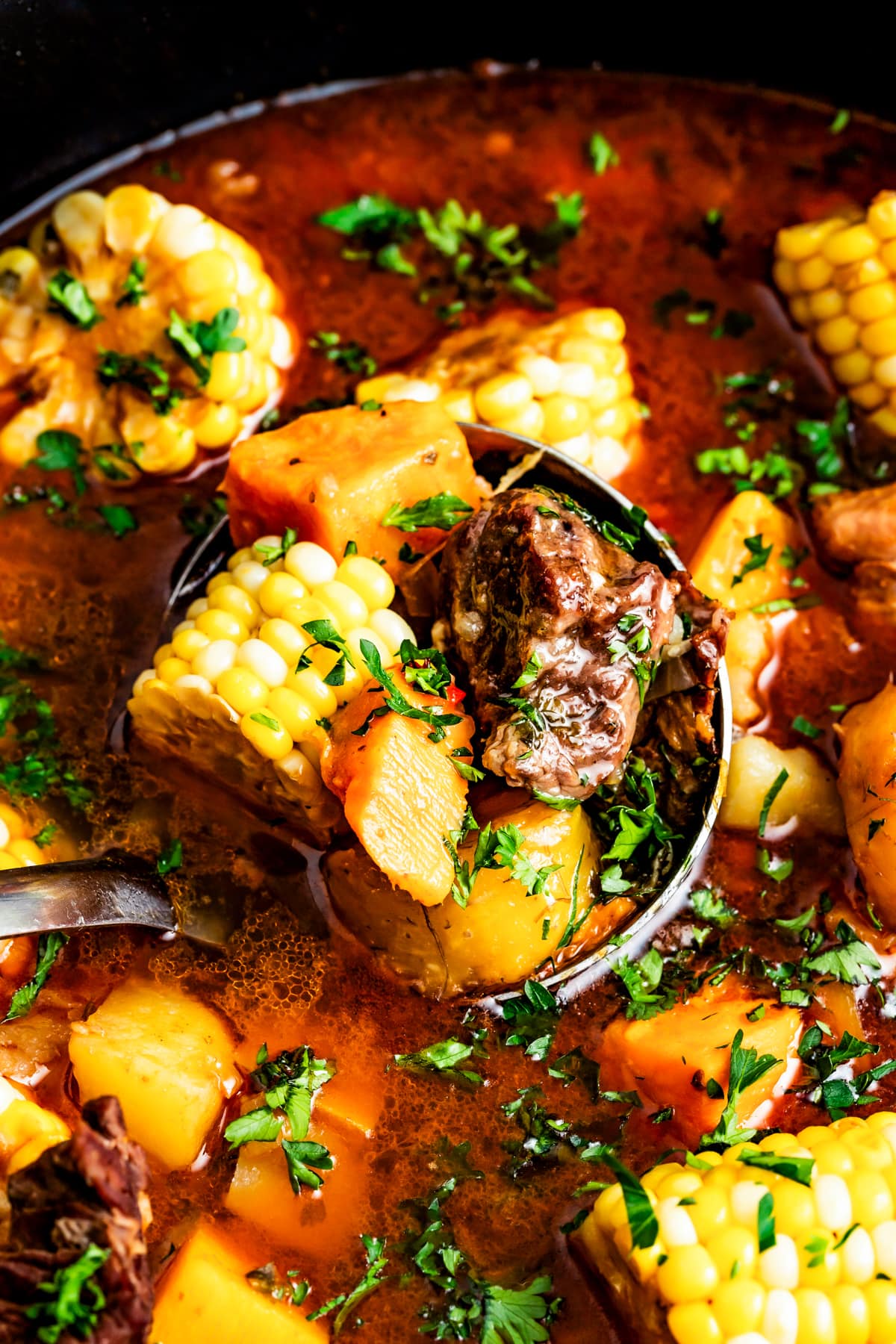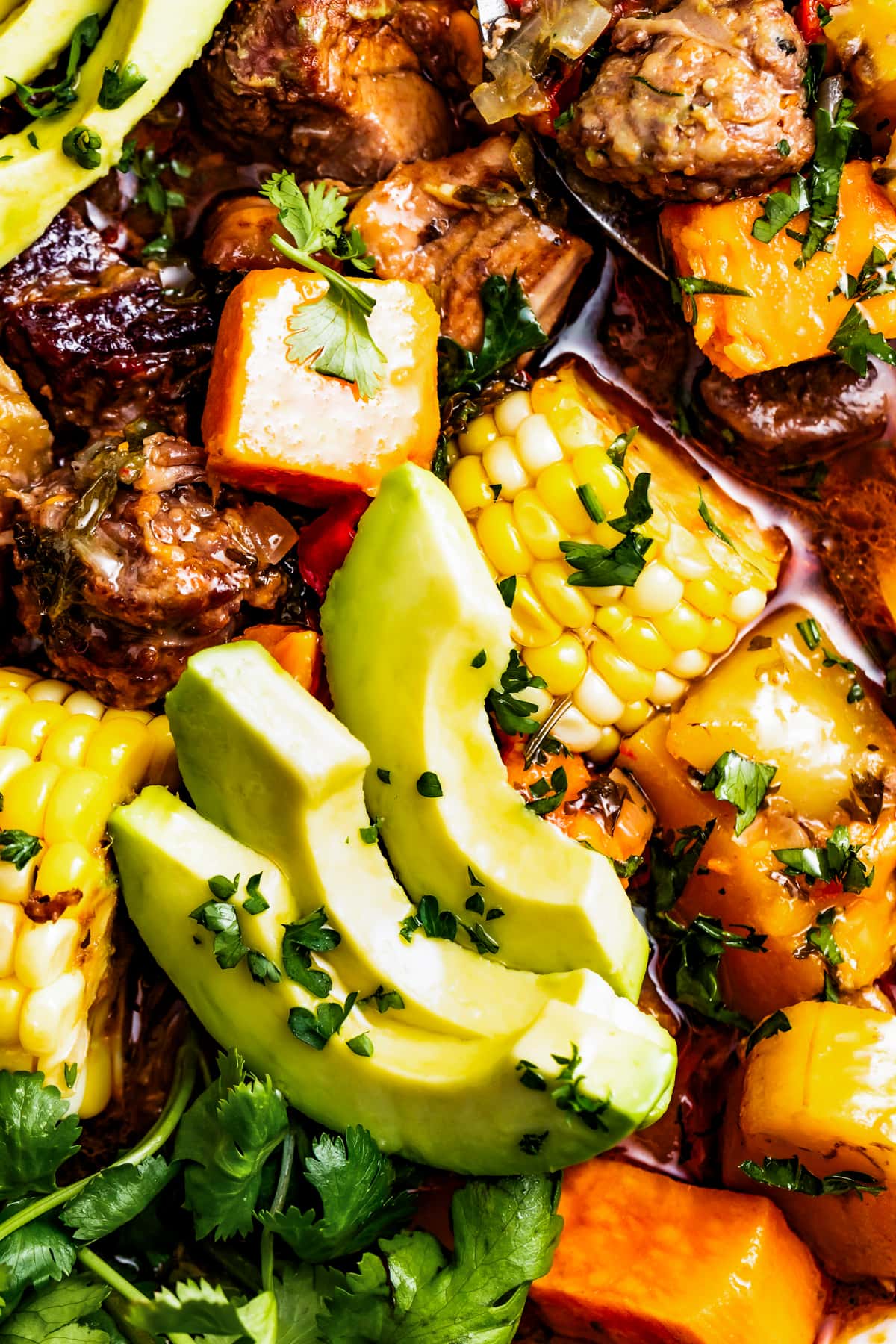Sancocho is a flavorful stew packed with various meats and starchy vegetables that will transport your taste buds to the vibrant beaches of the Dominican Republic. You’re going to love this hearty meat and veggie stew!

Easy Dominican Meat and Vegetable Stew
We live in a great big wide world. It would be a shame not to explore the seemingly endless cuisines scattered throughout it. Today I wanted to bring you a little slice of the Dominican Republic. I have only been to Punta Cana several times, but the Sancocho is something that stays with me long after our vacation. Sancocho is possibly my favorite regional dish – a rich stew often served as a celebratory dish.
This recipe is full of rich spices and vibrant flavors from a bright sofrito of onions, garlic, bell pepper, jalapeno, and fresh herbs. The stew is loaded with meat (3 kinds, to be exact) and a variety of starchy veggies. Get ready for a fabulous, filling one-pot meal.

What Is Sancocho?
Sancocho is a traditional stew from the Dominican Republic. It is made with an array of meats (sometimes up to 7!) and starchy veggies and is carried by a pungent Puerto Rican spice blend and a flavorful sofrito (a mixture of onions, peppers, garlic, and herbs). It is a cherished dish often reserved for special occasions, but that doesn’t mean you can’t make it today just because you feel like it.

Sancocho Recipe Ingredients
Here’s a list of ingredients needed to make this protein-packed meat and veggie stew. Be sure to scroll to the recipe card below for exact measurements.
For the Stew
- Salt & Pepper
- Smoked paprika, cumin, & dried oregano
- Chuck Roast, Pork Tenderloin, & Smoked Pork Sausage
- Red onion & garlic
- Jalapeno & Red Bell Pepper
- Chopped fresh parsley & chopped fresh cilantro
- Chicken stock: Beef or vegetable stock work as well.
- Sweet potato & Yukon gold potatoes
- Green plantains: You can usually find these near the bananas at the grocery store.
- Corn on the cob & Butternut squash

Swaps & Variations
Sancocho is a relatively flexible recipe. There are lots of ways to play with it to make it your own. Here are some fun variations for you to try out.
- Get creative with your protein. While Sancocho often has up to 7 different kinds of meat in it, this is not necessary. You can make Sancocho with chicken or beef if you like. If you are feeling adventurous, it is the perfect dish to experiment with more obscure meats such as lamb, goat, or oxtail.
- Surf and turf. Some Sancocho recipes include seafood. Try adding shrimp or another favorite shellfish. Make it fully pescatarian by omitting the beef, pork, and sausage and replacing it with seafood. Just note that you will want to add the seafood at the end of the recipe (when the veggies are almost done cooking) as opposed to at the beginning.
- Try different veggies. You can use a number of starchy veggies here. Try kabocha squash instead of butternut squash or yucca in addition to or instead of plantain. Taro also makes a great addition to this stew.
How to Make Sancocho Dominicano
Here is a quick rundown of how to make this Dominican stew. Be sure to scroll to the recipe card below for more detailed instructions.
- Make the spice blend. whisk together the sea salt, ground black pepper, smoked paprika, cumin, and dried oregano.
- Season the meat. Season the pork tenderloin and beef stew meat with the spice blend.


- Brown the meat. Heat the avocado oil over medium-high heat in a large, heavy-bottomed soup pot. Add the beef, pork, and smoked pork sausage. Stir to brown the meat on all sides.
- Sauté the sofrito Add the red onion, jalapeno, red bell pepper, garlic, fresh parsley, and fresh cilantro and sauté until aromatic.


- Add the chicken stock and bring to a boil. Reduce the heat to low. Simmer for 20 minutes.
- Cook the veggies. Add the sweet potatoes, waxy potato, and plantains. Simmer for 20 minutes. Add the corn and the butternut squash. Simmer for 15 minutes.
- Serve in bowls topped with avocado and cilantro.

Tips for Success
Sancocho Dominicano may sound intimidating but fret not. It’s actually quite simple to throw together. Just pay attention to the recipe card below and follow these tips and tricks, and you will find yourself with a delicious, authentic meat and vegetable stew.
- Don’t crowd the pan. When browning the meat, do not crowd the pan; otherwise, it will not sear properly. Brown in batches if you need to. Add all the meat back to the pot before continuing to the next step.
- Timing is everything. It may be tempting to add all of the veggies (plus the plantain) at the same time. Don’t do it. You will end up with soggy butternut squash and corn. Let the potatoes, sweet potatoes, and plantains simmer for 20 minutes before adding the butternut squash and corn. This way, all of the veggies should finish cooking at the same time.
- Be patient. Depending on the size of the cubes of your veggies, they may take a bit longer to cook. Give everything a test with a fork before your serve. Let the stew simmer for a bit longer if the veggies are not softened yet.

What to Serve with Dominican Sancocho
Dominican Sancocho truly is a one-pot meal. It’s full of protein, carbs, and veggies. You can easily enjoy it on its own, but it is even better when served with a side dish or two. Here are some ideas for you.

How to Store & Reheat Leftovers
- Allow the stew to cool completely before sealing it in an airtight container. Store it in the refrigerator for up to 4 days. When you are ready to enjoy, reheat the Sancocho Dominicano in a large pot on the stovetop over medium heat until heated through.
- To Freeze: Allow the Sancocho to cool completely before sealing it in an airtight container and storing it in the freezer for up to 3 months. When you are ready to enjoy, allow the stew to thaw in the refrigerator before reheating it over medium heat in a large pot on the stovetop.
More Stew Recipes
ENJOY!
For the Stew
- 3 teaspoons sea salt
- 1 teaspoon freshly ground black pepper
- 1 teaspoon smoked paprika
- 2 teaspoon cumin
- 2 teaspoons dried oregano
- ¾ pound cubed beef stew meat, like chuck roast
- ¾ pound pork tenderloin, cubed
- ½ pound smoked pork sausage, cut into 1 inch slices
- 2 tablespoons avocado oil
- 1 small red onion finely chopped
- 1 small jalapeno seeded and finely chopped (optional)
- 1 red bell pepper, finely chopped
- 3 cloves garlic, finely chopped
- ¼ cup chopped fresh parsley
- ¼ cup chopped fresh cilantro
- 9 cups chicken stock
- 1 large sweet potato, cubed
- 1 ½ cups cubed waxy potato, like Yukon Gold
- 2 green plantains, pealed and cut into 1 1/2 inch slices
- 2 corn cobs, quartered
- 1 cup butternut squash cubes, pealed, seeded
-
In a small bowl, mix together the sea salt, ground black pepper, smoked paprika, cumin, and dried oregano.
-
Season the pork and beef with the seasoning mixture.
-
Heat the avocado oil over medium-high heat in a large, heavy-bottomed soup pot.
-
Add the beef, pork, and smoked pork sausage and stir to brown the meat on all sides. Do not crowd the pan. Brown in batches if you need to. Just add all of the meat back to the pot before continuing to the next step.
-
Once the meat has browned, add the red onion, jalapeno, red bell pepper, garlic, fresh parsley, and fresh cilantro. Sauté until fragrant, about 4 to 5 minutes.
-
Add the chicken stock and bring to a boil.
-
Turn the heat to low and allow the stew to simmer for 20 minutes while you cut up the veggies.
-
Add the sweet potatoes, waxy potato, and plantains and simmer for 20 minutes.
-
Add the corn and the butternut squash and simmer for 15 minutes or until all the veggies are tender.
-
Remove from heat, divide the stew into bowls, top with avocado slices and cilantro, and serve.
- Chuck Roast: For beef stew, there is no better cut of meat than chuck. For the best tender flavor, get a chuck pot roast and cut it into 3/4-inch chunks.
- For the smoked pork sausage, I use Andouille Sausages.
- Do not crowd the pan when browning the meat because it will not sear properly. Cook it in batches if you need to.
- Timing is everything. It may be tempting to add all of the veggies at the same time, but you will end up with soggy butternut squash and corn. Follow the recipe and go step by step.
- Be patient. Depending on the size of your veggies, they may take a bit longer to cook. Give everything a test with a fork, and let the stew simmer for a bit longer if the veggies are not softened yet and if the beef is not fall-apart tender.
- Protein. Sancocho often has up to 7 different kinds of meat in it, and you can make Sancocho with chicken or, if you are feeling adventurous, it is the perfect dish to experiment with meats such as lamb, goat, or oxtail. Some Sancocho recipes include seafood. Try adding shrimp or another favorite shellfish. Just note that you will want to add the seafood at the end of the recipe (when the veggies are almost done cooking) instead of at the beginning.
- Try different veggies. You can use a number of starchy veggies. Try kabocha squash instead of butternut squash or yucca in addition to or instead of plantain.
Serving: 1 bowl | Calories: 365 kcal | Carbohydrates: 33 g | Protein: 22 g | Fat: 17 g | Saturated Fat: 4 g | Polyunsaturated Fat: 2 g | Monounsaturated Fat: 9 g | Trans Fat: 0.01 g | Cholesterol: 55 mg | Sodium: 1053 mg | Potassium: 1040 mg | Fiber: 5 g | Sugar: 11 g | Vitamin A: 4922 IU | Vitamin C: 32 mg | Calcium: 49 mg | Iron: 3 mg | Net Carbs: 28 g
Nutritional info is an estimate and provided as courtesy. Values may vary according to the ingredients and tools used. Please use your preferred nutritional calculator for more detailed info.

